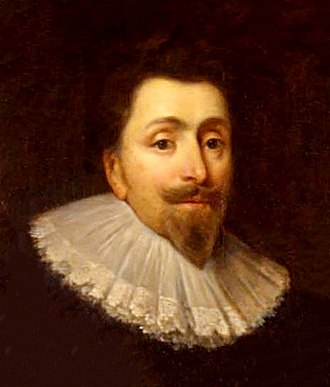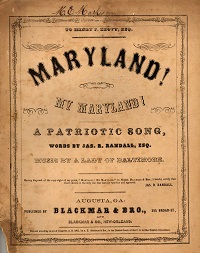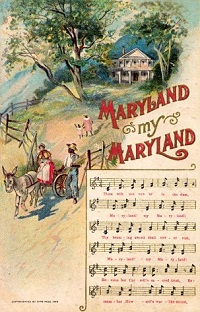Histories
Maryland's Beginnings
George Calvert,
1st Baron Baltimore, applied to Charles I for a royal charter for
what was to become the Province of Maryland. After Calvert died in
April 1632, the charter for "Maryland Colony" was granted by King
Charles I of England to George Calvert's
son, Cecilius Calvert, 2nd Baron Baltimore, on June 20, 1632.
The boundary of the grant included all of present day Maryland and
Delaware, and included all of the homeland of the Nanticokes as well as
the Conoy, Piscataway and parts of many other tribal homelands including
the Lenape, Powhatan, Susquehannock, Shawnee, and others. The first
settlement in Maryland was at St. Mary's on the Potomac River on the
western shore of the Chesapeake Bay in 1634. The settlers were permitted
to build their settlement there by the Potomac people who were already
moving their villages further upstream to avoid the frequent raids by
the Susquehannocks.
The colony was named in honor of Queen Henrietta Maria, the wife
of King Charles I. Led by Leonard Calvert, Cecil Calvert's younger
brother, the first settlers departed from Cowes, on the Isle of
Wight, on November 22, 1633 aboard two small ships, the Ark and the
Dove. Their landing on March 25, 1634, at St. Clement's Island in
southern Maryland, is commemorated by the state each year on that
date as Maryland Day. This was the site of the first Catholic mass
in the Colonies, with Father Andrew White leading the service. The
first group of colonists consisted of 17 gentlemen and their wives,
and about two hundred others, mostly indentured servants who could
work off their passage.
After purchasing land from the
Yaocomico Indians and establishing the town of St. Mary's, Leonard,
per his brother's instructions, attempted to govern the country
under feudalistic precepts. Meeting resistance, in February 1635, he
summoned a colonial assembly. In 1638, the Assembly forced him to
govern according to the laws of England. The right to initiate
legislation passed to the assembly.
In 1638, Calvert seized
a trading post in Kent Island established by the Virginian William
Claiborne. In 1644, Claiborne led an uprising of Maryland
Protestants. Calvert was forced to flee to Virginia, but he returned
at the head of an armed force in 1646 and reasserted proprietarial
rule.
Maryland soon became one of the few predominantly
Catholic regions among the English colonies in North America.
Maryland was also one of the key destinations where the government
sent tens of thousands of English convicts punished by sentences of
transportation. Such punishment persisted until the Revolutionary
War.
The founders designed the city plan of the colonial
capital, St. Mary's City, to reflect their world view. At the center
of the city was the home of the mayor of St. Mary's City. From that
point, streets were laid out that created two triangles. Located at
two points of the triangle extending to the west were the first
Maryland state house and a jail. Extending to the north of the
mayor's home, the remaining two points of the second triangle were
defined by a Catholic church and a school. The design of the city
was a literal separation of church and state that reinforced the
importance of religious freedom. The largest site of the original
Maryland colony, St. Mary's City was the seat of colonial government
until 1708.
About the Feudal Estate That Was Early Maryland
A Glimpse of Life in Early Maryland
The Calverts ruled with the force of kings as Lords
Baltimore (there were six). From 1637, when the English King granted Cecilius
Calvert dominion over Maryland (which early on included some of VA and all of
DE) until 1775, all the land was owned by the Calverts and 'granted,' which
meant in effect leased, by their authority as owners
to individual
(lesser) proprietors in blocks of 1,000 acres or more to form 'manors' or feudal
estates, in return for rent paid to the Proprietor (Calvert), or
from the
Proprietor's great manors (there were 62) himself directly to individual
'freeholders' or immigrants in smaller acreage also in return for rent, or
to friends, relatives etc. with various arrangements.
One reference said
that one of the Calverts' manors in Western Maryland (Allegany/Garrett Co?) was
10,000 acres and upon being forfeit to the United States after the Revolution,
was parceled out to the War veterans as bounty land in payment for their
service. The Calverts were (rightly) deposed by the Revolution.
These
'manors' were then parceled out by these lesser proprietors (wealthy nobles) to
'tenants' or small farmers (landless immigrants) in return for rents paid by
them to the 'lord of the manor.' The 'demesne' or main mansion and grounds
remained under the direct control of the Calverts.
This is why all the
early land 'grants' contained the name of Cecelius Calvert as the proprietor
(owner). Inheritance of these lands was permitted, but a fine, usually of one
year's rent, had to be paid BEFORE the land could be 'conveyed' to an heir. The
definition of 'heirs' changed from time to time, sometimes the eldest male,
never a female, or wife, sometimes the youngest male. The rents were continually
raised on the lands, to the consternation of the tenants. These rents were
estimated at the time of the Revolution to be in excess of 30,000 pounds
sterling per year!! [Thomas, p.97].
These manors were subdivided into
'hundreds', the old unit in England, being the amount of land that would roughly
support a company of men for defense of the land, or 100 men.
Suggested
reading: "Chronicles of Colonial Maryland", by James W. Thomas, Cumberland MD
1900
Contributed by Bob O'Neal
George Calvert
 Born: 1580 in Kiplin, North Yorkshire, England
Born: 1580 in Kiplin, North Yorkshire, England
Married Anne Mynne in 1604. They had 12 children: Cecil, who
succeeded his father as the 2nd Baron Baltimore, Leonard, Anne, Dorothy,
Elizabeth, Grace, who married Sir Robert Talbot, 2nd Baronet of Carton,
County Kildare, Francis, George, Helen, Henry, John (died young), and
Philip.
Died: 15
April 1632 (aged 52–53), in Lincoln's Inn Fields, London, England
George Calvert, 1st Baron Baltimore (1580 – 15 April
1632), was an English politician and colonial administrator. He achieved
domestic political success as a member of parliament and later Secretary
of State (1618-1625) under King James I. He was Proprietor of
the Avalon Colony, Newfoundland (1620–1632). He lost much of his political power after
his support for a failed marriage alliance between Prince Charles and
the Spanish House of Habsburg royal family. Rather than continue in
politics, he resigned all of his political offices in 1625, except for
his position on the Privy Council, and he declared his Catholicism publicly.
He was created Baron Baltimore in the Peerage of Ireland upon his
resignation. Baltimore Manor was located in County Longford, Ireland.
Calvert took an interest in the British colonisation of the
Americas, at first for commercial reasons and later to create a refuge
for persecuted Irish and English Catholics. He became the proprietor of
Avalon, the first sustained English settlement on the southeastern
peninsula on the island of Newfoundland (off the eastern coast of modern
Canada). Discouraged by its cold and sometimes inhospitable climate and
the sufferings of the settlers, he looked for a more suitable spot
further south and sought a new royal charter to settle the region, which
would become the state of Maryland. Calvert died five weeks before the
new Charter was sealed, leaving the settlement of the Maryland colony to
his son Cecil (1605–1675). His second son Leonard Calvert (1606–1647)
was the first colonial governor of the Province of Maryland.
Source: Wikipedia, where more details can be found.
Maryland! My Maryland!
The despot's heel is on thy shore
Maryland, my Maryland
His torches at thy
temple door
Maryland, my Maryland
Avenge the patriotic gore
That
flecked the streets of Baltimore
And be the battle queen of yore
Maryland,
my Maryland
Thou wilt not cower in the dust
Maryland, my Maryland
Thy
beaming sword shall never rust
Maryland, my Maryland
Remember Carroll's
sacred trust
Remember Howard's warlike thrust
And though thy slumberers
with the just
Maryland, my Maryland
Dear mother, burst the tyrant's chain
Maryland, my Maryland
Virginia should not call in vain
Maryland, my
Maryland
She meets her sisters on the plain
"Sic semper" 'tis the proud
refrain
That baffle's minions back o'Maine
Maryland, my Maryland
Arise,
arise in majesty again
Maryland, Maryland, my Maryland


Contact Us
Please email your comments, questions, and contributions to
State Coordinator
Rebecca Maloney
Assistant State Coordinator
Norma Hass



 Born: 1580 in Kiplin, North Yorkshire, England
Born: 1580 in Kiplin, North Yorkshire, England

